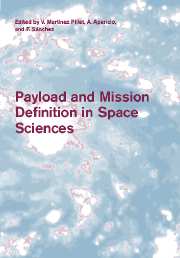Book contents
- Frontmatter
- Contents
- Preface
- Acknowledgements
- 1 The life cycle of an ESA science mission and how to get involved
- 2 Design issues for space science missions
- 3 Instrumentation in X-ray Astronomy
- 4 EUV and UV imaging and spectroscopy from space
- 5 The luminosity oscillations imager, a space instrument: from design to science
- 6 Hipparcos and Gaia: the development of space astrometry in Europe
- 7 Space Physics Instrumentation and Missions
- 8 Planetary observations and landers
2 - Design issues for space science missions
Published online by Cambridge University Press: 19 October 2009
- Frontmatter
- Contents
- Preface
- Acknowledgements
- 1 The life cycle of an ESA science mission and how to get involved
- 2 Design issues for space science missions
- 3 Instrumentation in X-ray Astronomy
- 4 EUV and UV imaging and spectroscopy from space
- 5 The luminosity oscillations imager, a space instrument: from design to science
- 6 Hipparcos and Gaia: the development of space astrometry in Europe
- 7 Space Physics Instrumentation and Missions
- 8 Planetary observations and landers
Summary
This set of lectures starts with a general view of space science missions, from their rationale to the sequence in which they have been defined in the last decades. A crucial aspect in the definition of the mission is its launch and cruise strategies. In the case of solar system bodies, also orbital insertion becomes a major issue in the mission planning. The different strategies based on gravity assists maneuvers, chemical and electric propulsion are detailed. As case examples the Rosetta, Bepi-Colombo and Solar Orbiter missions are studied in their different scenarios.
- Type
- Chapter
- Information
- Payload and Mission Definition in Space Sciences , pp. 17 - 88Publisher: Cambridge University PressPrint publication year: 2005
- 2
- Cited by

